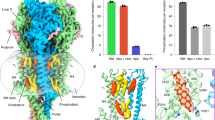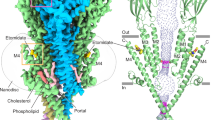Abstract
ATROPINE generally behaves as a competitive antagonist of acetylcholine (ACh) at muscarinic receptors1–9 but its onset and offset of action are slow. It has been suggested that the rates of onset and offset of atropine blockade are determined by the rates of binding to and dissociation from the ACh receptor4,5,10 a suggestion which at first sight seems incompatible with competitive blockade. An alternative explanation is that access of antagonist (in contrast to agonist) to the receptors, and escape from their vicinity on washing, is delayed or impeded in some way11–15. Experiments in which atropine is applied to a small superficial region of the tissue would seem to offer the best chance of reducing this access factor to a minimum and help in deciding which explanation for atropine's slow action is correct. The iontophoretic method presents itself as the method of choice, but until now, no such experiments have been carried out. The results of this type of experiment carried out on smooth muscle are described here. They reveal that the rate of offset of blockade by slow acting muscarinic antagonists can be more than ten times faster than that seen when antagonists are applied by their addition to the solution bathing (or perfusing) the muscle.
This is a preview of subscription content, access via your institution
Access options
Subscribe to this journal
Receive 51 print issues and online access
$199.00 per year
only $3.90 per issue
Buy this article
- Purchase on Springer Link
- Instant access to full article PDF
Prices may be subject to local taxes which are calculated during checkout
Similar content being viewed by others
References
Clark, A. J. J. Physiol., Lond. 61, 547–556 (1926).
Stephenson, R. P. Br. J. Pharmac. 11, 379–393 (1956).
Arunlakshana & Schild, H. O. Br. J. Pharmac. 14, 48–58 (1959).
Paton, W. D. M. Proc. R. Soc. Lond. B 154, 21–69 (1961).
Paton W. D. M. & Rang, H. P. Proc. R. Soc. Lond. B 163, 1–44 (1965).
Waud, D. R. Pharmac. Rev. 20, 49–88 (1968).
Pauling, P. J. & Petcher, T. J. Nature 228, 673–674 (1970).
Rang, H. P. Nature 231, 91–96 (1971).
Baker, R. W., Chothia, C. H., Pauling, P. & Petcher, T. J. Nature 230, 439–445 (1971).
Rang, H. P. Proc. R. Soc. Lond. B 164, 488–510 (1966).
Furchgott, R. F. Pharmac. Rev. 7, 183–265 (1955).
Thron, C. D. & Waud, D. R. J. Pharmac. exp. Ther. 160, 91–105 (1968).
Roberts, F. & Stephenson, R. P. Br. J. Pharmac. 58, 57–70 (1976).
Ginsborg, B. L. & Stephenson, R. P. Br. J. Pharmac. 51, 287–300 (1974).
Colquhoun, D., Henderson, D. & Ritchie, J. M. J. Physiol., Lond. 227, 95–126 (1972).
Del Castillo, J. & Katz, B. Proc. R. Soc. Lond. B 146, 339–356 (1957).
Bolton, T. B. J. Physiol., Lond. 250, 175–202 (1975).
Bolton, T. B. Proc. R. Soc. Lond. B 194, 99–119 (1976).
Barlow, R. B., Scott, K. A. & Stephenson, R. P. Br. J. Pharmac. 21, 509–522 (1963).
Waud, D. R. J. Pharmac. exp. Ther. 158, 99–114 (1967).
Gutfreund, H. Enzymes: Physical Principles (Wiley, London 1972).
Author information
Authors and Affiliations
Rights and permissions
About this article
Cite this article
BOLTON, T. Rate of offset of action of slow-acting muscarinic antagonists is fast. Nature 270, 354–356 (1977). https://doi.org/10.1038/270354a0
Received:
Accepted:
Issue Date:
DOI: https://doi.org/10.1038/270354a0
This article is cited by
-
Muscarinic receptor subtypes controlling the cationic current in guinea‐pig ileal smooth muscle
British Journal of Pharmacology (1997)
-
The rate of action of cyclic ammonium and sulfonium analogues of acetylcholine
Experientia (1979)
Comments
By submitting a comment you agree to abide by our Terms and Community Guidelines. If you find something abusive or that does not comply with our terms or guidelines please flag it as inappropriate.



